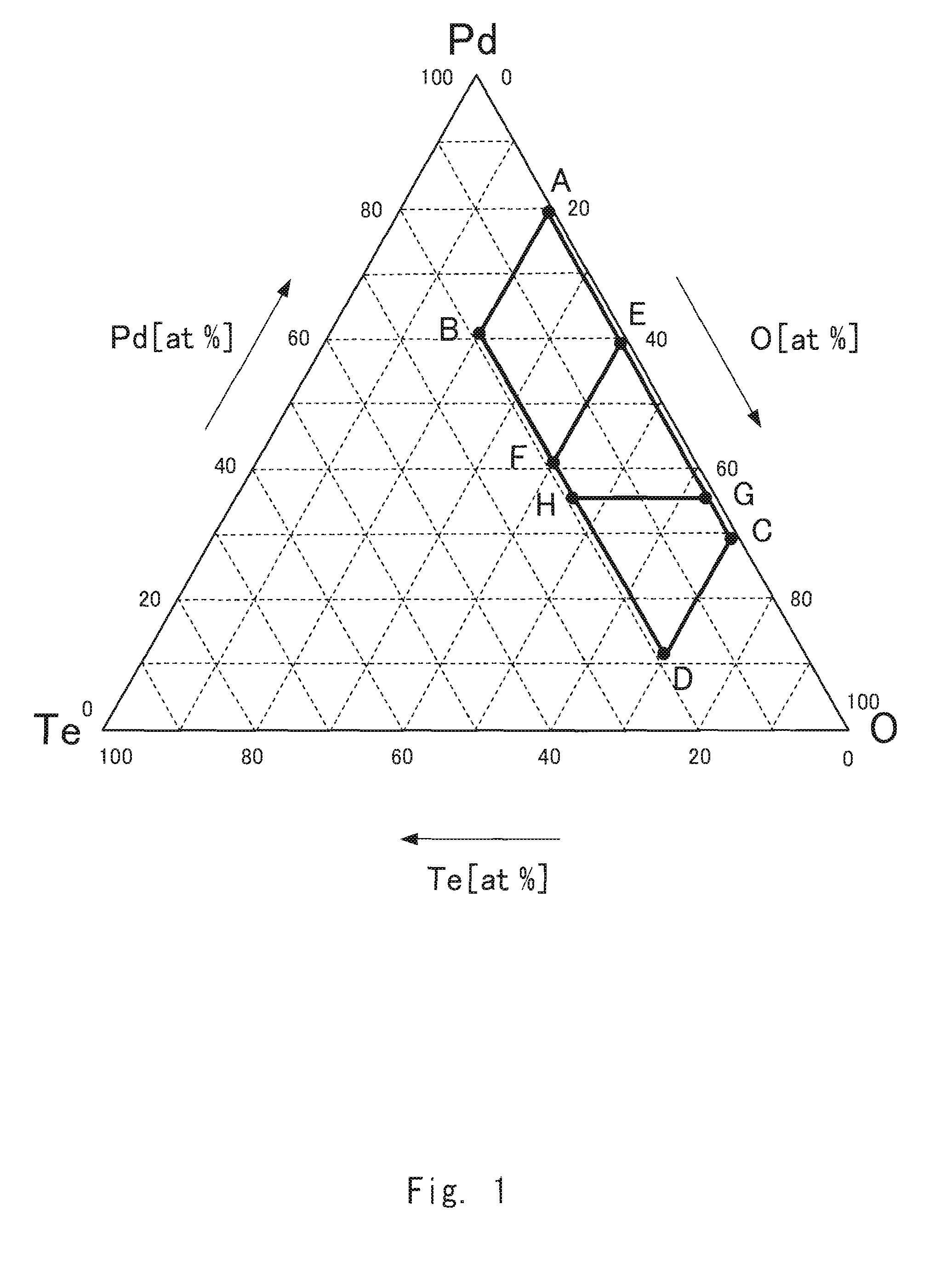Information recording medium and method for production thereof
a technology of information recording and information, applied in the field of writeonce information recording medium, can solve the problems of reducing the production cost, affecting the quality of information recording, so as to reduce the production cost, reduce the transmission difference, and the effect of less expensiv
- Summary
- Abstract
- Description
- Claims
- Application Information
AI Technical Summary
Benefits of technology
Problems solved by technology
Method used
Image
Examples
example 1
[0057]In Example 1, information recording media were prepared having the same layer structure as that of the information recording medium 6 shown in FIG. 3, except that the reflective layer was eliminated.
[0058]In the present example, investigation was made for a case where the recording layer composed of a Te—O—Pd material is used, where Pd is used as the element M.
[0059]A ZnS—SiO2 dielectric layer with a thickness of 20 nm was formed using a ZnS—SiO2 target, a recording layer with a thickness of 10 nm composed of Te—O—Pd material was formed in an atmosphere of sputtering gas composed of Ar (0 to 50 sccm) and O2 (5 to 50 sccm) using a target composed of Te—Pd, a ZnS—SiO2 dielectric layer with a thickness of 30 nm was formed using a ZnS—SiO2 target, on a 1.2 mm-thick transparent substrate formed of a polycarbonate resin, the substrate having a laser beam guiding groove with a groove pitch of 0.32 μm. These layers were formed in this order by a sputtering method.
[0060]An optically tr...
example 2
[0076]In Example 2, information recording media were prepared having the same layer structure as that of the information recording medium 6 shown in FIG. 3, except that the reflective layer was eliminated. The Te—O-M material was used for producing the recording layer, where element M was not Pd as in Example 1, but Ru, Rh, Ag, Re, Os, Ir, Pt, and Au.
[0077]A ZnS—SiO2 dielectric layer with a thickness of 20 nm was formed using a ZnS—SiO2 target, a recording layer with a thickness of 10 nm composed of Te—O-M was formed using a target composed of Te-M, where M denotes any of Ru, Rh, Ag, Re, Os, Ir, Pt and Au in the present example, in an atmosphere of sputtering gas of Ar (0 to 50 sccm) and O2 (5 to 50 sccm), and a ZnS—SiO2 dielectric layer with a thickness of 30 nm was formed using a ZnS—SiO2 target, on a 1.2 mm-thick transparent substrate formed of a polycarbonate resin, the substrate having a laser beam guiding groove with a groove pitch of 0.32 μm. These layers were formed in this ...
example 3
[0081]In Example 3, an information recording medium having the same layer structure as that of the information recording medium 1 shown in FIG. 2 was prepared.
[0082]A recording layer composed of Te—O—Pd with a thickness of 20 nm was formed using a target composed of Te—Pd, in an atmosphere of sputtering gas of Ar and O2, on a 1.2 mm-thick transparent substrate formed of a polycarbonate resin, the substrate having a laser beam guiding groove with a groove pitch of 0.32 μm. An optically transparent layer with a thickness of 100 μm was formed on a surface thereof using an ultraviolet curable resin transparent with respect to the laser beam (Disc 23). The composition of the recording layer was the same as that of Disc 6 in Example 1.
[0083]Disc 23 was evaluated for the initial C / N ratio, the amount of C / N ratio deterioration after the accelerated aging test, and the amount of the transmittance difference, in the same manner as in Example 1.
TABLE 3Amount ofC / N ratioTe—O—Pddeteriorationcom...
PUM
| Property | Measurement | Unit |
|---|---|---|
| thickness | aaaaa | aaaaa |
| thickness | aaaaa | aaaaa |
| thickness | aaaaa | aaaaa |
Abstract
Description
Claims
Application Information
 Login to View More
Login to View More - R&D
- Intellectual Property
- Life Sciences
- Materials
- Tech Scout
- Unparalleled Data Quality
- Higher Quality Content
- 60% Fewer Hallucinations
Browse by: Latest US Patents, China's latest patents, Technical Efficacy Thesaurus, Application Domain, Technology Topic, Popular Technical Reports.
© 2025 PatSnap. All rights reserved.Legal|Privacy policy|Modern Slavery Act Transparency Statement|Sitemap|About US| Contact US: help@patsnap.com



